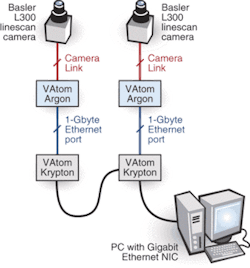Gigabit Ethernet gains favor at VISION 2003
At the October 2003 VISION trade show in Stuttgart, Germany, members of the Gigabit Ethernet committee once again convened to formulate a Gigabit Ethernet standard for machine vision (seeVision Systems Design, December 2003, p. 13). On the show floor, two companies, Pleora Technologies (Kanata, ON, Canada; www.pleora.com) and GigaLinx (Ramat Gan, Israel; www.gigalinx.net), demonstrated board-level products based around the technology.
By formatting image data into IP packets using TCP/IP offload engines (TOEs), Pleora has developed a number of data-conversion modules based on TOE processing technology that connects Camera Link, LVDS, PAL, NTSC, and other cameras to Gigabit Ethernet networks (seeVision Systems Design, Feb. 2003, p. 7).
GigaLinx entered the machine-vision/image-processing market with a series of products designed to add high-speed interfacing and digital-signal-based processing to Gigabit Ethernet systems. The first two of these products, vAtom Argon and vAtom Krypton, are nonstandard 12 × 8-cm boards that use switched-packet Giagbit Ethernet to transfer data to and from system boards.
The vAtom Argon can support dual Base or single Medium Camera Link configurations. With four 10/100/1000 Ethernet channels, the board can remotely link cameras up to 100 m from a host PC and transfer a sustained bandwidth of up to 512 Mbytes/s over the Ethernet connection. "To support the board," says Albert Burbea, chief technical officer of GigaLinx, "free drivers are supplied for cameras including the 1000 Series from JAI Pulnix (Sunnyvale, CA, USA; www.jai.com) and the 310 Series from Basler (Ahrensburg, Germany; www.baslerweb.com).
The vAtom Krypton also features four external Gigabit Ethernet ports for connection to vAtoms or to a PC. The digital-signal-processing board also features two autonomous C6414 32-bit fixed point digital-signal processors (DSPs) from Texas Instruments (TI; Dallas, TX, USA; www.ti.com). These each run at 720 MHz and are connected to a switched Gigabit Ethernet network using two Gigabit Ethernet channels per processor.
To program the boards for image processing, GigaLinx supplies a GigaLink Image-Level Open Protocol that allows programs to transfer images between boards or to split image data between boards. Running with TI Code Composer Studio, this arrangement permits functions such as binary manipulation and convolution to run on the DSPs.
A GigaLinx customer is currently using the boards in a textile-manufacturing application. "In this application," says Burbea, "the cloth is running on a web at approximately 100 m/min." Two Basler L300 linescan cameras are independently interfaced to two vAtom Argon boards. Images from these Base configuration Camera Link cameras are then interfaced to two vAtom Krypton boards using a single Gigabit Ethernet port on each Argon board.
After image data are processed by a vAtom Krypton board, results are transferred to the second board over a Gigabit Ethernet port. The results from both processing operations are combined and transferred into a PC using a Pro 1000-Gbit Ethernet NIC from Intel (Santa Clara, CA, USA; www.intel.com). According to Burbea, single-unit prices of a single-port Atom, a quad-port Atom, and the Krypton board are $1000, $2000, and $3000, respectively. The TI software-development environment adds another one-time $3500 investment to the system.
In April 2004, the company is expected to augment its product offerings with vAtom Neon and vAtom Cobalt boards. While both boards will offer gate-array programmability through the use of Virtex II 1000 gate arrays from Xilinx (San Jose, CA, USA; www.xilinx.com) and eight Gigabit Ethernet ports, the Neon will also allow up to 2-bytes DDR SDRAM to be added to the board.

